Water lily or water lily, she is also a nymphea (lat. Nymphaéa ) is a plant of the water lily family that lives in stagnant freshwater reservoirs almost everywhere. Belongs to the class of dicotyledonous angiosperms. It got its Latin name according to a legend in which a nymph unrequitedly in love with Hercules from grief turned into a beautiful flower above the water. The water lily is often confused with the lotus (lat. Nelúmbo). Meanwhile, this is the only representative of the family of the same name.
plant description

According to the botanical description, the water lily is a perennial plant with a long stem, which keeps the leaf apparatus and the actual flower bowl in the surface position. Due to the powerful root system, the water lily is firmly held in the ground. The roots are so strong and fleshy that people have long used them in the food industry. The presence of proactive substances in the seeds and tubers of the plant allows them to be used for the purposes of traditional medicine.
In the process of vegetation under water, buds ripen in the nodes of the stem, which then develop into leaves. Most of them tend to the surface. The dimensions of the sheet plate are very variable. From 15 – 20 cm in nymphs in European reservoirs to half a meter in plants grown in Asia. The shape of the leaf is rounded with a heart-shaped notch at the point of attachment of the petiole.
In wild water lilies, the leaf is dark green, dense. But there are species whose leaves are painted in pink, red, red-brown, brownish colors. Some varieties give the so-called “brindle” color with burgundy splashes.
This feature attracts aquascapers all over the world. A bright spot of red leaves will become the center of any underwater composition. The underside of the leaf of brindle-colored nymphs is purple, and that of green ones is emerald green.
The height of the bush reaches one and a half meters, and in the wild up to three meters. Water lilies live along the banks of slowly flowing rivers and in stagnant reservoirs: ponds and swamps.
In central Russia, water lilies bloom in mid-spring, marking the onset of warm days. With the beginning of flowering, you can not wait for return frosts.

The palette of nymphaeum petals is a huge variety. From crystal white to blood red. From pale blue to deep blue. Such a number of shades is bred, mainly, by selection. The size of the flower bowl and the number of petals vary enormously.
The aroma of the nymph is the pride of many peoples. The image of a blooming lily adorns the coats of arms of countries of different continents. The oil is included in perfume compositions. But the main quality of the water lily is its unsurpassed decorative effect. Who would not want to have a picturesque pond, overgrown with delightful flowers, not far from the house?
Below is a photo of a water lily flower that will help you imagine what this amazingly beautiful, graceful plant looks like in the garden:
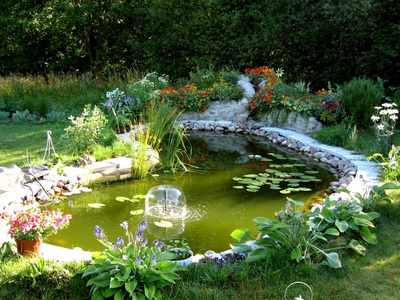


Kinds
The following are some notable species from over fifty varieties of the water lily.
White water lily (lat. Nymphaéa alba ). She is white. Inhabitant of the European continent. It is found on the Volga, in Western Siberia and in the Urals. Listed in the Red Book. The flower is solitary bisexual, on a flexible pedicel. Double perianth with 4-5 sepals. Flower size up to 30 cm. The arrangement of the petals is tiled. In the center, the pistils and stamens are yellow-orange. Popularly called Odolen-grass or Mermaid flower. The color range of petals of a white water lily varies from snow-white to pale pink. There are morphs of soft cream color. This feature is used by breeders to create yellow water lilies.
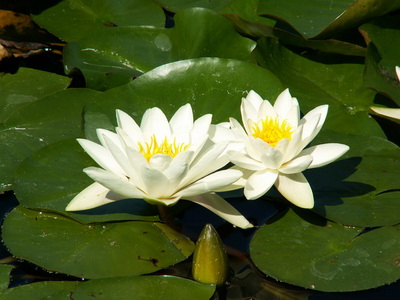
Water lily red (lat. Nymphaea rubra ). The birthplace of this nymph is India. It got its name from the reddish color of the leaves. Most often it is confused with the selective red form of the lotus. The bright pink flower of this lily with a diameter of up to 20 cm is used to decorate decorative ponds. According to summer residents, the red water lily winters well in central Russia.
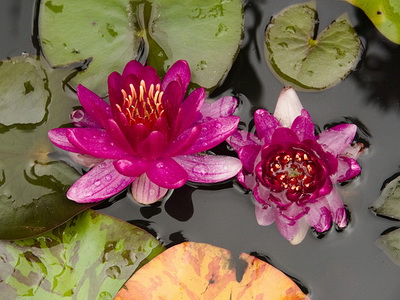
Star-shaped water lily (lat. Nymphaea nouchali ). The range is from Afghanistan and Pakistan to Taiwan. The Star Lotus is the national symbol of Sri Lanka. A typical inhabitant of ornamental ponds. The flowers are purple with red edges. But there are also instances of fuchsia.

Blue water lily (lat. Nymphaea caerulea ). The blue water lily grows in East Africa, is found in India and Thailand. Flower diameter up to 20 cm. They have an easily recognizable sugary aroma. The calyx is four-membered. Sepals are green on the outside, pale blue or white on the inside. The arrangement of the petals is spiral. The petals are light blue or blue, smaller than the sepals. The juice of the plant has a high content of alkaloids.

Types of water lilies should not be confused with varieties and hybrids bred by breeding. Among them are Virginalis (creamy, with oblong petals), Escarboucle (burgundy, almost black, with rounded petals), Moorey (yellow, with pointed petals), Tropical Blue Variegata (blue, with stiletto-shaped petals) and dozens and hundreds more beautiful flowers worthy of placement in the best catalogs of flower companies.
Such a variety of breeding forms is due to a not very complex plant propagation system.
Reproduction
Water lily propagates by seeds or rhizome shoots.
The heart of the bud is the pistil (or pistils) surrounded by stamens. Pollination is done by insects. After pollination, the petals wither and fall off, the fruit remains on the pedicel – a seed box, which, in the process of maturation, falls under water. The seeds are still near the mother plant for some time and resemble glued fish caviar. Then they get wet and sink to the bottom.
The collected seeds are planted in containers with water and a small layer of soil. At a temperature of about 27 ° C and good lighting, the seeds germinate in a week. As the seedlings grow, the water column increases. After the young plant reaches a height of 10 – 12 cm, it can be moved to a permanent place.
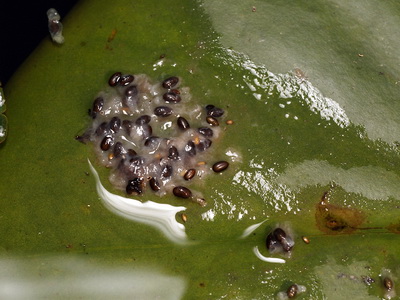

However, seed propagation is mainly used by breeders in the development of new varieties and variety types. The reason is vegetative reproduction, which is not simple in the nymphaeum, but very simple.
The rhizome is taken out of the water and the leaves are removed. Then cut into pieces. There must be at least one kidney in the segment. Sections are treated with ash. A piece of rhizome is placed in a container filled with water and silt.
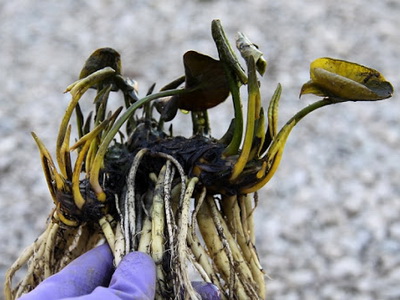
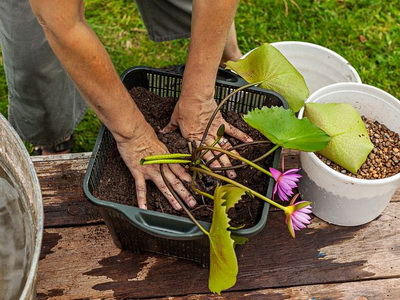
Plants with a good habitus are used as transplant material. Very young bushes do not take root well even in very good conditions. An abrupt change in water parameters and the height of the water column are especially critical for the nymphaeum.
Landing Rules
It is not difficult to grow a water lily, even an inexperienced gardener can handle the care of this plant, it is enough to study the information about the features of this flower. A suitable time for planting a water lily is the warm summer months.
If you decide to plant them in a natural reservoir, then you should choose winter-hardy varieties. In a small country pond created by one’s own hands, it is better to plant the nymphaeum in a separate container in order to take it to a warm room with the onset of cold weather.
Before planting, it is recommended to add lake sapropel, clay granules and boiled peat into the soil. Expanded clay with a fraction of 0.5 mm or medium-sized pebbles can serve as a soil for transplantation. Layer thickness 4 – 5 cm.
The best soil for a water lily will be the muddy deposits of a nearby pond. It always has a lot of humus and detritus. If you cannot vouch for the cleanliness of this reservoir, then it is better to purchase a special substrate for nymphs in the store.

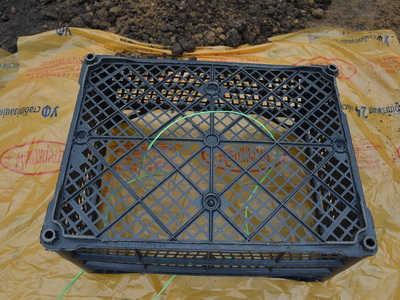

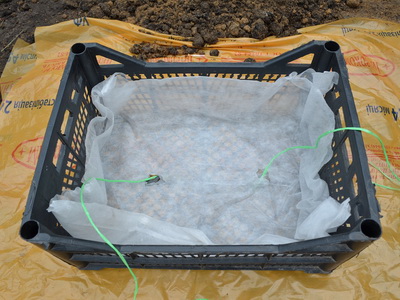
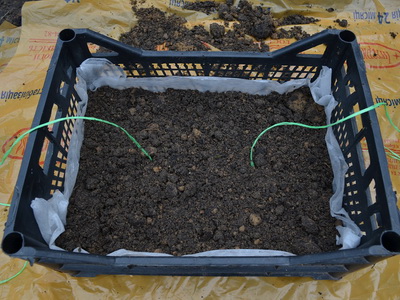


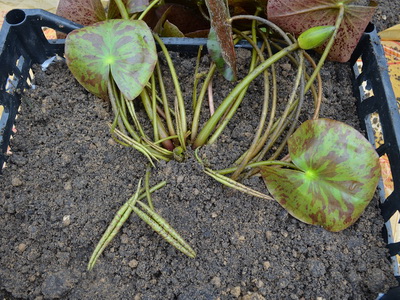


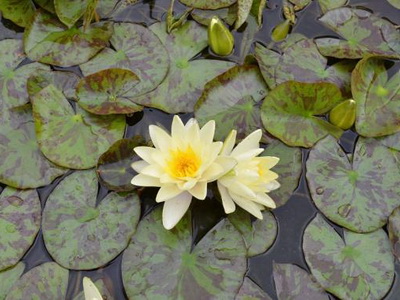
When planting, make sure that the growth bud is not buried in the soil. Then the lily pot is placed in well-heated shallow water until a sprout appears. As the leaves grow, the planting is rearranged deeper.
Care
Nymphaeans love stagnant water or a small current. Therefore, they are ideal for a small country pond. As a rule, the plant does not cause trouble during care, you should only follow some recommendations.
In nature, plants live in water with the following parameters: dGH from 0.5 to 4°, pH up to 6.5. The ideal water temperature is 24-27°C. However, breeding nymphs adapted and began to tolerate dGH well up to 16° and pH up to 7.7. The only thing that southern breeding forms cannot survive is a drop in temperature. Below 20°C, the plant stops growing. At 10 ° in shallow water, the nymphaeum will die.
Water lilies are photophilous plants. Therefore, they must be planted in well-lit places.
Mineral fertilizers for top dressing (K + N + P) are best purchased in liquid form and applied according to the instructions when topping up and changing water. In addition, it should be remembered that water lilies, especially red shades, are very sensitive to the content of iron in the water. With a sufficient concentration of FeSO4, they will delight you with a bright color for a longer time.
In good conditions, lilies grow quite quickly and can please the gardener with flowering in the first year after transplantation. Also, the nymphaeum has another positive quality. Due to intensive growth, it leaves practically no nutrients for the development of algae. So the pond will be free of mud.
The main care for the nymphaeum is the mechanical removal of old, damaged along the edges and holey leaves, along with petioles. Plant pruning is well tolerated, growth rates are not reduced.

Under good conditions, the pond overgrows fairly quickly. Daughter bushes begin to appear immediately after fruiting is completed. If nothing is done, then the mother bush will decrease in size and become indistinguishable from the children. Therefore, it is recommended to regularly inspect and thin out the “family nest”.







